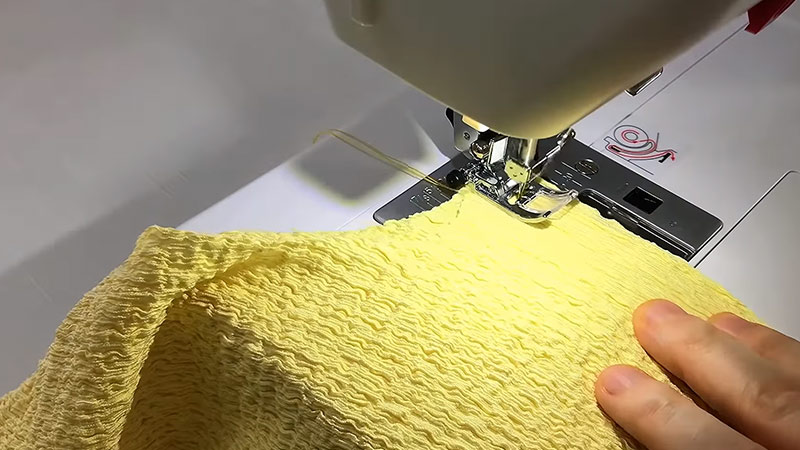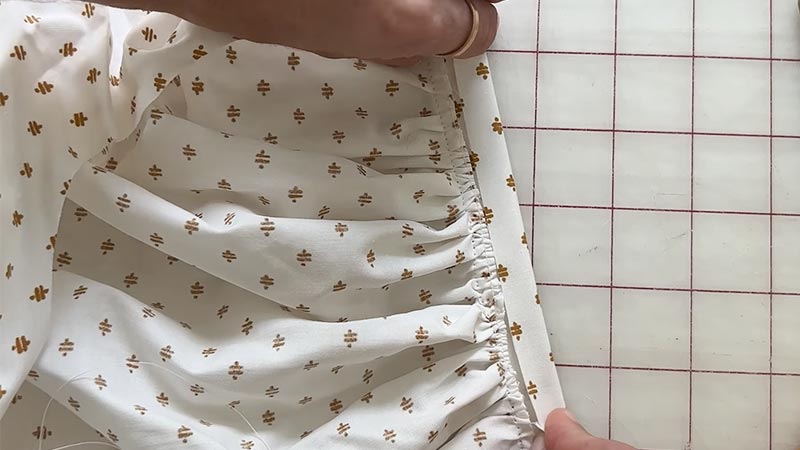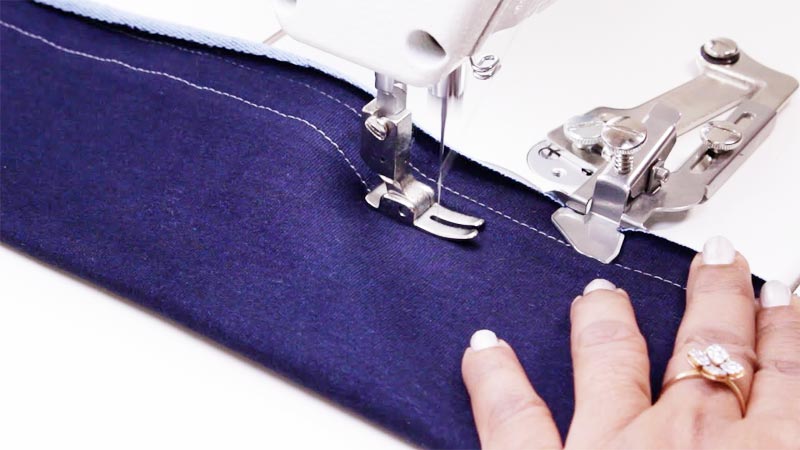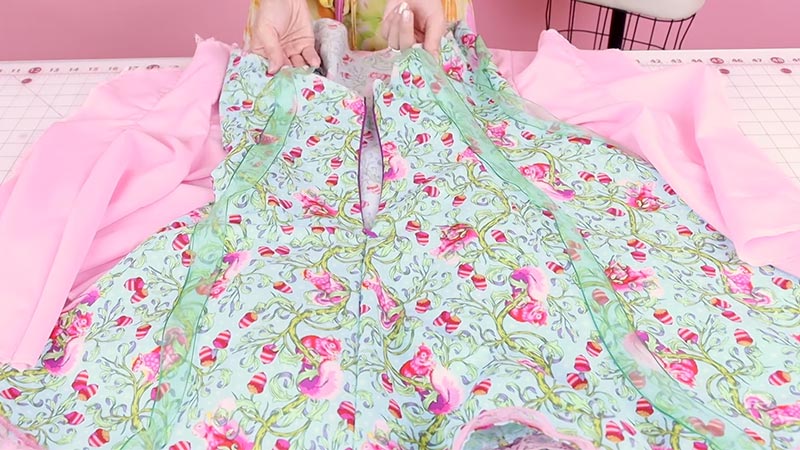The world of fashion and dressmaking is a realm of endless creativity, where every stitch and seam tells a unique story. Among the many threads that weave a garment’s tale, horizontal sewing lines stand as essential characters in the narrative.
These lines, placed strategically across a dress, are the silent architects of fit, style, and structure. But what are these horizontal sewing lines called, and how do they influence the art of dressmaking?
In this exploration, we delve into the terminology and significance of these lines, uncovering the ways in which they not only define a dress’s form but also shape the very essence of fashion, lending a touch of elegance, comfort, and individuality to every creation.

What Are Horizontal Sewing Lines On A Dress Called?
Horizontal sewing lines on a dress are commonly known as “seams” or “stitching details.” These seams play a crucial role in dressmaking, serving diverse functions. The hemline is the lowermost horizontal seam that can be straight, curved, or asymmetrical.
The waistline defines the point where the bodice meets the skirt and can vary in placement, like the natural waist, empire waist, or drop waist. Bodice seams provide structure and shape for the upper part of the dress.
Yokes are horizontal lines across the shoulders or upper back. Panel seams divide the dress into sections, while gathering and ruching create fullness and texture.
Tiers and ruffles use multiple horizontal seams to add layers, and sashes or belts cinch the dress at the waist, combining functionality and aesthetics.
What Are the Different Types of Horizontal Sewing Lines on a Dress?

Horizontal sewing lines on a dress are integral to the garment’s structure and style, and they come in various types, each with its unique purpose and visual effect.
Let’s explore the different types of horizontal sewing lines found on a dress:
Hemline
The hemline is the most recognizable horizontal sewing line on a dress, running along the bottom edge. It can be straight, creating a crisp and clean finish, or curved and asymmetrical for a more dynamic and artistic touch.
The choice of hemline style greatly influences the overall look of the dress.
Waistline
Waistlines are integral for defining the dress’s shape. They can be located at the natural waist, emphasizing an hourglass figure, or placed higher as an empire waist, or lower as a drop waist for a more relaxed fit. Each waistline type creates a distinct silhouette.
Bodice Seams
Bodice seams, such as princess seams or darts, are often located in the upper part of the dress. These sewing lines provide shaping and structure to ensure a perfect fit in the bust and torso areas.
Yoke
A yoke is a horizontal sewing line that spans across the shoulders or upper back. Yokes add structural support, helping the dress maintain its shape and structure. They also contribute to the overall style of the dress.
Panel Seams
Panel seams divide the dress into sections, creating both design interest and shaping. These seams can enhance the fit of the dress by allowing for more tailored construction.
Gathering and Ruching
Horizontal lines created by gathering fabric, either subtly or dramatically, add fullness and texture to the dress. They are often used to create a soft and romantic look.
Tiers and Ruffles
Multiple horizontal sewing lines are used to create tiers or ruffles, adding layers and a sense of movement to the dress. These lines can contribute to a playful or sophisticated style.
Sashes and Belts
Sashes or belts are horizontal elements that cinch the waist, providing definition and style. They can be both functional and decorative, enhancing the overall look of the dress.
Why Are Horizontal Sewing Lines Important in Dressmaking?

Horizontal sewing lines play a pivotal role in dressmaking, with their importance extending far beyond the seemingly simple act of joining two pieces of fabric together. These lines, strategically placed along a dress, serve as the backbone of its structure, fit, and aesthetics.
Understanding why horizontal sewing lines are so crucial in dressmaking is fundamental for any aspiring fashion designer or avid seamstress.
Here are the key reasons why these lines are of paramount importance:
Fit and Comfort
Horizontal sewing lines are essential for tailoring a dress to the unique contours of the wearer’s body. They help ensure that the garment fits comfortably, accentuates the right areas, and conceals any imperfections.
Silhouette Definition
By creating horizontal lines at various points on a dress, such as the waist or hips, designers can define the silhouette. A well-placed horizontal line can enhance an hourglass figure, give the illusion of height, or create a more relaxed, flowy look.
Aesthetic Appeal
The choice of horizontal sewing lines greatly influences a dress’s visual appeal. Straight, curved, or asymmetrical lines, along with various finishing techniques, can transform a dress from simple to stunning.
They can also add texture, depth, and visual interest to the garment.
Structure and Support
Certain sewing lines, particularly those in the bodice or yoke, provide structural support to the dress. They maintain its shape and ensure it stays in place during wear, enhancing both the look and functionality of the garment.
Versatility
Horizontal sewing lines offer incredible versatility. They can adapt a dress to different occasions and styles, from casual to formal, vintage to contemporary. By choosing the right sewing lines, a single pattern can be transformed into various designs.
Fabric Draping
These lines influence how the fabric drapes and moves on the body. They can create different drape effects, contributing to the overall appearance and comfort of the dress.
Design Detail and Creativity
Horizontal sewing lines provide designers with a canvas for creativity. They can be used to add unique design details, such as gathers, pleats, ruching, tiers, and ruffles.
Additionally, they can cinch the waist and introduce sashes, belts, or other elements for both functional and aesthetic purposes.
Historical and Iconic Significance
Many iconic dresses in the annals of fashion history are celebrated for their distinctive horizontal sewing lines. Understanding the impact of these lines not only respects fashion traditions but also offers opportunities for innovation and contemporary reinterpretation.
How Can You Enhance Dress Design With Horizontal Sewing Lines?

Enhancing dress design with horizontal sewing lines is a creative and practical approach that can transform a simple dress into a stunning and unique garment.
Here are some ways to achieve this:
Create Shape and Structure
Horizontal sewing lines can be strategically placed to create structure in the dress. For example, bodice seams, darts, or yokes can shape the upper part of the dress to enhance the wearer’s silhouette.
Define the Waist
Waistlines, whether natural, empire or drop, help define the waist area, creating an hourglass shape or a more relaxed fit. Choosing the right waistline can greatly impact the overall style.
Add Visual Interest
Horizontal sewing lines break up large areas of fabric and add visual interest. Different line styles, such as straight, curved, or asymmetrical, can create texture and depth in the design.
Incorporate Decorative Elements
Horizontal lines can be used for decorative purposes. For instance, ruching, gathering, or tiers add texture and detail to the dress, enhancing its aesthetics.
Achieve Movement
Tiers and ruffles created by horizontal sewing lines add layers and movement to the dress. This can make the dress feel more playful and dynamic.
Emphasize Themes and Eras
Specific sewing lines can evoke different eras or themes in fashion. For example, a drop waistline might remind one of the 1920s flapper style, while an empire waistline can have a romantic, vintage feel.
Flatter Body Proportions
Horizontal lines can flatter specific body proportions. For instance, princess seams can elongate and flatter the torso, making them a popular choice for many body types.
Create a Unique Design
Experiment with the placement and style of horizontal sewing lines to create a unique and personalized dress design. Mixing and matching different lines can result in a one-of-a-kind garment.
Reflect Fashion Trends
Keep an eye on current fashion trends and incorporate them into your dress designs. Certain types of sewing lines may be in vogue and can add a contemporary touch to your creations.
Consider Fabric Choice
The type of fabric you choose can also impact the design. Lightweight, flowy fabrics work well for lines that create movement, while structured fabrics are ideal for lines that define shape.
FAQs
What tools and equipment are needed to create horizontal sewing lines on a dress?
To create horizontal sewing lines on a dress, you’ll need a sewing machine, pins, scissors, measuring tape, fabric, thread, needles, and an iron for pressing.
Are there any notable fashion designers known for their creative use of horizontal sewing lines?
Several fashion designers, like Christian Dior and Balenciaga, are celebrated for their innovative use of horizontal sewing lines in their iconic and timeless dress designs.
What are the most common mistakes to avoid when working with horizontal sewing lines?
Common mistakes to avoid when working with horizontal sewing lines include uneven stitching, misaligned seams, improper tension, using the wrong thread, and neglecting to press.
Are there any cultural or regional variations in the use of horizontal sewing lines in dress design?
Yes, cultural and regional variations exist, with Asian cultures often using horizontal sewing lines to create traditional garments like kimonos and cheongsams, reflecting their unique aesthetics.
How can DIY enthusiasts incorporate horizontal sewing lines in their homemade dresses?
DIY enthusiasts can incorporate horizontal sewing lines by selecting suitable patterns, experimenting with different line styles, and paying attention to precision and details to enhance their homemade dresses.
To Recap
In the intricate world of dressmaking, where fabrics become canvases and stitches tell stories, horizontal sewing lines emerge as the unsung heroes.
Throughout our journey, we have unveiled the terminology and significance of these lines, which go far beyond their technical purpose.
From the fundamental hemline to the decorative ruching, these lines are the architects of style, structure, and individuality. They sculpt a dress’s silhouette, evoke historical eras, and reflect contemporary trends.
They offer a canvas for creativity and a vehicle for personal expression. In concluding our exploration of horizontal sewing lines, we recognize their transformative power in the world of fashion, where every seam and stitch is an ode to the art of dressmaking.
Leave a Reply